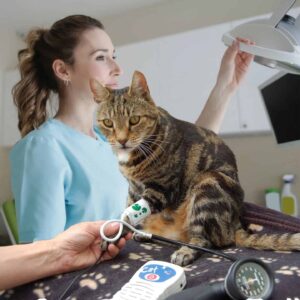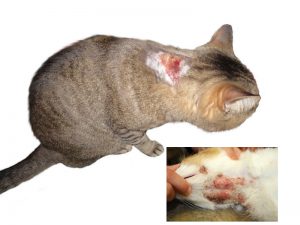Reasons One Might Consider Declawing Their Cat
Part 2
Ron Hines DVM PhD
I see my job as providing you with unbiased information regarding your cat’s health care options. I am not suggesting that you declaw your cat. What I am suggesting is that you disregard the blanket statements of bullies in various facets of your life. People in and out of the veterinary profession can be judgmental, closed-minded, and insistent on their rights to vilify or make decisions for others. Sometimes, it is the elderly, the ill, the frail, and the lonely who need a feline companion the most. Sometimes it’s a maladjusted, quirky cat that needs a human companion and protector the most.
I mentioned in another article that I estimated that problems associated with a cat’s clawing could be solved without surgery in perhaps 85% of cat households. I also mentioned that our cat, Oreo, was never declawed because our family did not find it necessary. I just clip and filed his front claws from time to time. For the other, perhaps 15%, properly performed by a skilled surgeon who understands feline paw anatomy, front claw removal might still be the most humane solution. Militant “cat interest” groups have a disproportionate influence on American society. They disseminate and lobby for simplistic solutions to complex problems. I will always tell you what I believe to be true – but it won’t always be what they, want you to hear. Here are some things about a cat’s claws that those folks are not going to mention:
Cat-scratch Disease / Bartonella henselae
Cat-scratch disease (CSD) is caused by a minute bacteria (a coccobacillus) named Bartonella henselae. These bacteria generally make their home in the cells that line the blood vessels (the endothelium) of a cat’s body, but they appear free in its blood from time to time as well. Veterinarians and physicians used to believe that when a cat or a human was infected with Bartonella, it caused a disease that was quite mild and only lasted a short time. That opinion is changing. The most common ways one becomes infected with Bartonella henselae is through the scratch of a cat, a bite from a cat or a bite from a cat flea.
In many ways, cat scratch disease is similar to Lyme disease. They both have the ability to produce a tremendous variety of symptoms or no symptoms at all. They both involve the complex interplay between pets, parasites, and humans. They are both quite difficult to diagnose because they produce signs that mimic so many other diseases. Both can produce lingering illnesses that are very hard to treat despite the use of antibiotics. In both diseases, the upswing in cases is due to changing human lifestyles, changing demographics and better tests to identify those that are infected. (read here) Neither organism is easily eliminated with antibiotics. (read here, here, here & here) Neither have effective vaccines.
When a cat harbors Bartonella anywhere in its body; you can assume that at points in its life, it will harbor the organism on its claws as well. (read here) It is estimated that more than half of cats residing in areas where fleas are common harbor Bartonella at some point in their lives. (read here)
You can also assume that at some point the owner of a cat will get scratched. Most often, but not always, that scratch was inadvertent. Perhaps the cat was held or petted longer than it wanted to be, or held incorrectly. Perhaps the cat was startled. Perhaps you stepped on its tail. Perhaps a young child pursued it. Perhaps it was play pouncing or kneading. (read here)
Physicians still believe that most people who contract cat scratch fever recover with no lasting damage. But they are also realizing that a host of health problems that were not previously recognized as being related to bartonellosis, the cat scratch organism, was the underlying cause. Those situations occur most commonly in the elderly, the very young and folks whose health is tenuous for a variety of reasons. However, it can occur in anyone, and from year to year it is being diagnosed more frequently in people. (read here, here, here & here)
What People Need To Be Particularly Cautious About This Disease?
People With Heart Issues:
Heart valve distortions and resulting heart murmurs are quite common in us as we get older. (read here) Some cases need no treatment, some can be treated conservatively with medication, and in some, heart valves needs to be replaced. In other cases, the thin lining layer of the heart becomes inflamed (endocarditis). Cat owners in all those situations are more susceptible to the complications of cat scratch fever should they be exposed to it. (read here, here, here, here & here) Sometimes biofilms form and blood tests for bartonella remain negative. (read here) In those situations, the diagnosis can only be made by removing a small biopsy specimen (snippet of tissue) from the patient’s heart valve itself. (read here)
The Weakened Immune Systems Of The Elderly
When a human is inadvertently scratched and develops cat scratch fever, it is their immune system that must battle and defeat the organism. During our teenage and middle adult lives, most of us have a robust combative immune system. But as we age, our ability to fight infections decreases. There are other people who are born with defects in their immune systems that make them less able to combat infections. Still others lose their ability to fight infections like Bartonella because of conditions such as AIDS (read here) or cancer treatment medications. Still others become more susceptible to Bartonella due to a joint replacement or various forms of Lupus. (read here & here) Anything that lowers a cat-owner’s CD4+ T cell count is likely to make that person more susceptible to bartonella infections. (read here) That can be no more than a person having to battle two different infections at the same time. (read here) Not only are people with weakened immune systems more susceptible to bartonellosis, it appears that cats with immune systems weakened by feline leukemia virus might be more susceptible to bartonellosis as well. (read here)
Transplants
People who have received organ transplants are at an increased risk for developing cat scratch fever. (read here & here)
Eyes
Bartonella henselae can also cause a variety of serious eye inflammations, leading to blindness. (read here, here, here & here)
Less Documented But Claimed By Some Physicians
Bartonella has the ability to cause chronic inflammation in just about any part of the body. Generally, it is persistent fever and enlarged lymph nodes that lead physicians to suspect and test for bartonella involvement. (read here) But just because a person tests positive for bartonella and/or improves when given an antibiotic known to cure bartonellosis is not proof that whatever symptoms that person experienced were caused by bartonella. Read some articles that suggest as link between the presence of bartonella and psychiatric issues, the worsening of those issues and other bizarre syndromes. But keep in mind that cause and effect have not been satisfactorily proven. (read here, here, here & here)
Bartonella As A Threat To Your Veterinarian
Who is most likely to be scratched by a cat? Of course, it is your veterinarian, his or her employees and shelter workers. So, it should come as no surprise that veterinarians and folks that work with many cats lead the list when it comes to Bartonella henselae exposure. (read here, here & here) Veterinary medicine is a high-stress profession; so a lot of the symptoms seen in these studies could also have causes unrelated to, or only partially related to their exposure to cat scratch fever.
Are There Other Diseases That Cats Can Transmit Through Their Claws?
Yes. There are many.
Rickettsia felis is the latest candidate. But as to proven transmission through a scratch, we really do not yet know one way or the other. (read here) Like Bartonella, R. felis can also catch a ride to humans and other cats on cat fleas. When Rickettsia felis infects people, the fever, rash, and headache it produces are indistinguishable from cat scratch fever. Occasionally, it affects on people are considerably more severe. In some areas of the world, this organism has become even more common than Bartonella. R. felis wasn’t recognized as a threat to humans until 1991. Again, it is your veterinarian who is at the front of the line for exposure risk. (read here) Diagnostic tests (including PCR tests) for exposure to this organism are not particularly sensitive. (read here) Although there is more awareness among the medical community than there once was, we still know quite little about the many ways Rickettsia felis it is transmitted. Other organisms can infect humans through the scratch of a cat. Pseudomonas bacteria are one. (read here) Pasteurella and strep bacteria are two more. (read here, here & here)
Antibiotic Resistant Bacteria
When your cat must receive antibiotics frequently or for extended periods of time, strains of antibiotic-resistant bacteria are always a danger that might occur. (read here). Should those resistant bacteria gain entrance to you, such as through a scratch or a bite, there can be very few treatment options left for your physician. (read here) Say, just for example, that you are a member of a group that takes your house cats to nursing homes and long-term care facilities to keep the resident’s spirits up. (read here) People confined to those facilities long for interaction with pets and people. Volunteering to visit with your pet is a very compassionate thing for you to do. Or what if it were your mother, your father or your dearest friend who was scratched when they came to visit your home? (read here & here)
Enough About People! — Are There Cats Whose Own Health Might Improve If They Were Declawed?
Yes.
A few of those cats exit too:
Itchy Cats With Allergies That Traumatize Themselves With Their Claws
Allergies are a more common problem in dogs. But some cats have very itchy allergies too. (read here, here, & here) Those cats can literally tear their skin to pieces scratching. If it’s just a flea allergy, that can be easily corrected – eliminate flea exposure. If it’s a food allergy, it can be controlled with special diets. Antihistamines do not provide much help for these cats. What does bring cats relief are corticosteroids and powerful medications such as cyclosporin both of which bring a host of life-shortening side effects of their own. (read here, here & here) Are long-term, life-shortening corticosteroids, tranquilizers, cytotoxic drug or Elizabethan collars more humane than declawing some of these cats? Or are those cats just out of luck?
Eosinophilic Granulomas Complex
EGC might also be considered an allergy, since the eosinophils that are found in excess in EGC are often in excess in other allergic conditions. Ulcers often form in the cat’s mouth, but they sometimes appear elsewhere on your cat’s body. You can read more about this baffling disease here. Veterinarians are still unsure why some cats develop EGC, or what triggers the intense scratching and self-trauma that some forms of this disease produce. (read here) Flea control must be scrupulous. Claws can be blunted and smoothed weekly, and claws can be capped. But if not tended to, claws will do damage. Is declawing some of these cats off the table because of rigid philosophies?
Cats With Unusually Fragile Skin
Due to human cruelty, some cats have genetically fragile skin. Skin that is easily torn by claws. If you go to the NCBI index and search for Devon Rex & Spinx cat, you will find over 30 articles regarding the rare diseases these unfortunate creatures suffer from. Animal cruelty is one of the prices of human vanity. Both breeds are highly susceptible to skin disease. However, animal militants the AVMA and the CFA remain hush, hush about that – it’s easier to focus on claws than on eliminating a life of suffering. If you want a healthy cat, find it at your local animal shelter.
In other cats, fragile skin is due to adrenal gland over-activity – an illness similar to the Cushing’s disease more common in dogs. (read here) In some of these cats, their skin fragility was due to high doses of corticosteroids given to address their other health issues. In other instances, fragile skin appears to be the result of disease processes elsewhere in their body. (read here, here, & here) In still others, inborn genetic defects are thought to be the problem. (read here) Dealing with secondary bacterial infections in all of these pets can require periodic antibiotics. With time, those bacteria will become antibiotic-resistant – a threat to the cat, and to you. Cats with autoimmune skin disease (pemphigus) also develop unhealthy skin – just as we humans sometimes do. (read here) They too might require periodic antibiotic and other immunosuppressive treatment. In 30–90% of the cases, the tissue surrounding the cat’s claws (the cat’s nail beds) are affected and harbor those infections (often staphylococcus) as well. (read here or ask me for Manning1982)
I do not believe that people in imperfect health or facing other issues should be denied the companionship of a cat or vice versa because of the rigid dogma of some. Loneliness is epidemic in the western world today, cats are put down every day because homes are unavailable, and wretched cat colonies are no substitute for caring owners. I have no ethical problem recommending that cats belonging to a client of mine with any of these concerns be front declawed the way I performed the surgery. The procedure got its bad reputation from ham-handed veterinarians who removed far too much tissue. I always inform the cat’s owner that a cat bite or perhaps even a cat flea bite could pose similar dangers.
Perhaps you will be successful in solving your cat-claw-related issues in less drastic ways. I hope so. Perhaps you feel that declaw surgery is not appropriate for your cat facing any of these issues. Perhaps you are by nature or inclination dead set against it. That is also fine. But family decision like these should be yours to make without duress and bullying. I think your cat would agree.
You are on the Vetspace animal health website
Visiting the products that you see displayed on this website help pay the cost of keeping these articles on the Internet.












